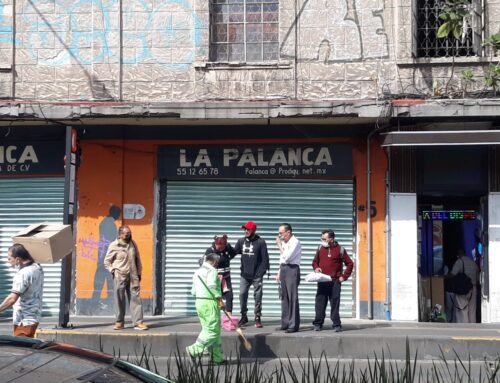 Homelessness is a drain on the economy–not just a social problem. When the workforce can no longer keep a roof over its head, what is to become of the economy?
Homelessness is a drain on the economy–not just a social problem. When the workforce can no longer keep a roof over its head, what is to become of the economy?
Even before Hurricane Sandy destroyed thousands of units of housing, homelessness was surging in New York City. Today, there are more than 80,000 people in our homeless shelters. But this is not all. According to the Furman Center at NYU, there are 200,000 more New Yorkers who are doubled up in apartments with extended family or with strangers, because they are unable to afford a market rent. These are the near-homeless that are not part of Department of Homeless Services statistics, but who are also residing in precarious housing situations.
Lawyers for Sandy victims left homeless have gone to court to decry that despite $40 million spent on homeless services for them, these New Yorkers are still in hotels. Forty million is a great deal of money; yet it is dwarfed by the $800 million a year spent on homeless services in New York City. Despite this significant spending, every year the number of homeless families grows.
Like the rest of us, New Yorkers in hotels, shelters, and doubled up, all want a permanent home from which pursue their dreams. As a social worker, I’ve come to see the anxiety, chaos and stagnation that homelessness causes. Because homelessness brings so much debilitating mental distress that interferes with functioning, I have also come to see homelessness as a business problem.
Business publications including Forbes have written about the financial costs to business of homelessness. The U.S. Interagency Council on Homelessness was created to respond to this embarrassing national problem, in a country of otherwise great wealth. The distress of homelessness hampers productivity and stifles innovation. Consistent with the theories of Abraham Maslow, humans who struggle to get their basic survival needs met are not going to engage in higher thinking and self actualization. So they do not make the best employees.
Homeless people are an anxious lot; homelessness occupies their minds, causes discord in their romantic and familial relationships, and interferes with proper sleep and rest cycles. As the slog through the system drags out with no apartment at the other end, it breeds distrust. There is nothing sadder than the stony face of a homeless child, numbed from the chaos of shelter life. They will not reach their full potential as thinkers. They have elevated cortisol levels, the stress hormone that should only be present when they are fleeing grave danger. Compassion and empathy, two qualities that are necessary for a healthy adult life, cannot develop easily in children who spend each day feeling unprotected.
The business world supports education initiatives in inner city schools. CEOs know the importance of improving education to the bottom line; but business leaders have not yet brought any weight to bear on the city to solve homelessness. The stay out of the public discussion of homelessness and policy discussions of how to solve it. Yet homelessness will do more permanent cognitive damage to kids than an overcrowded classroom or having art cut from the curriculum. Philanthropic aid to schools will not turn poor children into thriving children.
Despite the consensus that there are “too many homeless”—shared by DHS, the general public, advocates for the poor, and poor people alike—the last large building expenditure on homeless New Yorkers during the past five years was not for new apartments, but to build a new 78,000 sq foot “intake” center on East 151 Street in The Bronx. The “light-filled” building got accolades in architecture journals, but it did not add one unit of housing to ameliorate homelessness. Instead, homeless people report here to be interviewed as an entryway into the shelter system—they will if accepted, be sent to a far less beautiful building to sleep.
All practical thinking would conclude that this building should have been built as permanent apartments. Meanwhile, the City spends an average of $3,000 a month to shelter each homeless family, in hotels, shelters or sub-par apartments that the average New Yorker would not pay one third that amount for on the free market.
New apartment projects reserve a minority percentage of units as “affordable housing.” But affordability is relative. In the places social workers labor, we meet clients who have children with incomes of less than $15,000 a year. For them, a $1,500 apartment, reasonable to some, is completely out of reach.
People made homeless by Sandy were given $15 million worth of caseworkers (i.e. social workers who are paid very badly). Their lawyers, in arguing for the city to extend their stays in city hotels, revealed that for all this money, not one of the 400+ Sandy victims in hotels had gotten permanent housing yet. This is money that could have gone to building real housing or providing real rent subsidies.
A simple look at the city’s own language for its housing strategy sheds a lot of light on what’s wrong. The city refers to its affordable housing program as “apartment lotteries.” Lottery means allotment or distribution of anything by fate or chance. What in the world is a city as large as New York, a dynamic place that carefully considers most aspects of its public policy and urban planning, doing using chance distribution as the core of its housing policy? We’ve given more thought in the past two years to how big the biggest soda should be here than we have to how to make sure New Yorkers have a place to live. How long can business stay dynamic when the average worker has as much change of scoring an affordable apartment as he does of hitting the Mega Millions?
I have personally seen a family wait eleven years for a public housing transfer; seen a family finally get repairs to the apt, including a front door that locks, only to be evicted a few months later; and seen people expelled from a shelter because they arrived ten minutes after curfew. Last week I worked with a woman who was hospitalized after she returned to her homeless shelter in the Bronx to find all her belongings had been stolen from the basement. Medicaid paid for her stay in the inpatient psychiatry unit, for 7 days, at a cost of $2,000 per day. This money could have paid one year of modest rent for an apartment, from which she could have lived, gone to work, and taken part in the fabric of her city.
In fact, I recently worked on a 19 bed psychiatry unit in the city. Of the nineteen there my first day of work, a full 16 were homeless, and were discharged to shelters. While no place to live is not the only problem each one has, it is clear that a home is a significant source of human well being. That the majority of our patients were homeless raises an interesting question: are they homeless because they have a mental illness, or are they mentally ill because they are homeless?
It is not sensible to allot $800 million to help homeless people, then not use any of that money to building new housing. That kind of money could build permanent housing for all that need it, a base from which to pursue dreams, care for family and participate in the economy. I may be a social worker, but I don’t advocate injecting a social worker into every homeless family. Not every homeless family needs a social worker but every homeless family needs a home. With a shift toward building apartments, we could give them all one. It’s the ultimate in human resource development and New York business will benefit. It is important for the social services sector to remember that it is not enough to put significant amounts of money toward these problems of survival—the policy in place must be rational and geared toward long term solutions, not stop gap measures. This is not only because short term help is short term, but because it is undignified and does not consider the worth and needs of the person. Our social work training taught us that we must treat clients with dignity. Long term solutions that do not waste resources are the only dignified ones, and as social workers we must advocate vocally for this to be reflected in our homeless policies.






Leave A Comment